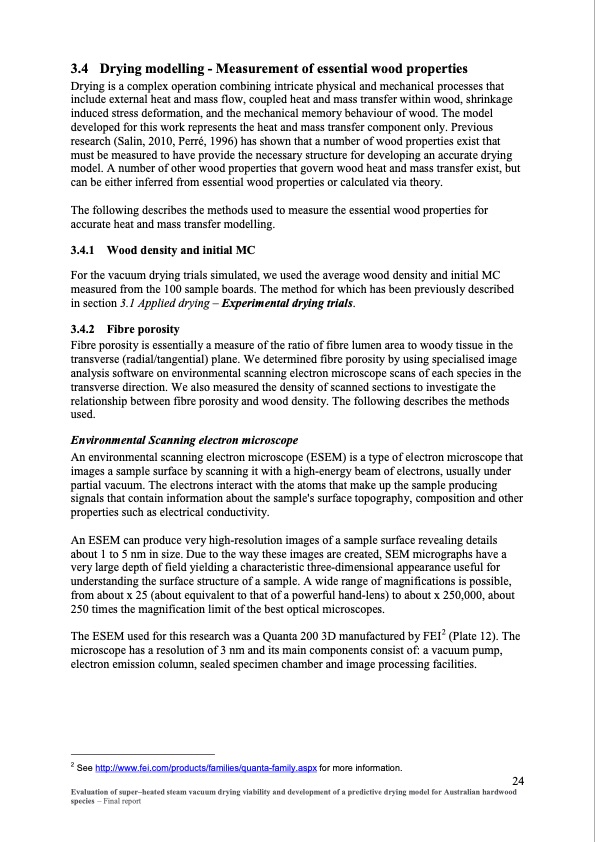
PDF Publication Title:
Text from PDF Page: 031
3.4 Drying modelling - Measurement of essential wood properties Drying is a complex operation combining intricate physical and mechanical processes that include external heat and mass flow, coupled heat and mass transfer within wood, shrinkage induced stress deformation, and the mechanical memory behaviour of wood. The model developed for this work represents the heat and mass transfer component only. Previous research (Salin, 2010, Perré, 1996) has shown that a number of wood properties exist that must be measured to have provide the necessary structure for developing an accurate drying model. A number of other wood properties that govern wood heat and mass transfer exist, but can be either inferred from essential wood properties or calculated via theory. The following describes the methods used to measure the essential wood properties for accurate heat and mass transfer modelling. 3.4.1 Wood density and initial MC For the vacuum drying trials simulated, we used the average wood density and initial MC measured from the 100 sample boards. The method for which has been previously described in section 3.1 Applied drying – Experimental drying trials. 3.4.2 Fibre porosity Fibre porosity is essentially a measure of the ratio of fibre lumen area to woody tissue in the transverse (radial/tangential) plane. We determined fibre porosity by using specialised image analysis software on environmental scanning electron microscope scans of each species in the transverse direction. We also measured the density of scanned sections to investigate the relationship between fibre porosity and wood density. The following describes the methods used. Environmental Scanning electron microscope An environmental scanning electron microscope (ESEM) is a type of electron microscope that images a sample surface by scanning it with a high-energy beam of electrons, usually under partial vacuum. The electrons interact with the atoms that make up the sample producing signals that contain information about the sample's surface topography, composition and other properties such as electrical conductivity. An ESEM can produce very high-resolution images of a sample surface revealing details about 1 to 5 nm in size. Due to the way these images are created, SEM micrographs have a very large depth of field yielding a characteristic three-dimensional appearance useful for understanding the surface structure of a sample. A wide range of magnifications is possible, from about x 25 (about equivalent to that of a powerful hand-lens) to about x 250,000, about 250 times the magnification limit of the best optical microscopes. The ESEM used for this research was a Quanta 200 3D manufactured by FEI2 (Plate 12). The microscope has a resolution of 3 nm and its main components consist of: a vacuum pump, electron emission column, sealed specimen chamber and image processing facilities. 2 See http://www.fei.com/products/families/quanta-family.aspx for more information. 24 Evaluation of super–heated steam vacuum drying viability and development of a predictive drying model for Australian hardwood species – Final reportPDF Image | Evaluation of super-heated steam vacuum drying

PDF Search Title:
Evaluation of super-heated steam vacuum dryingOriginal File Name Searched:
PN08_2047_Vacuum_Drying_Reviewed_Report.pdfDIY PDF Search: Google It | Yahoo | Bing
5,000 BF Shipping Container Lumber Dry Kiln For Quality Lumber The 5,000 BF container kiln consists of one 40 foot high-cube aluminum shipping container... More Info
Shipping Container Lumber Dry Kilns by Global Energy Global Energy designed and developed the container kiln back in 1991. The purpose is to give access to portable sawmill owners, furniture makers, and small business the value added profit of dry kiln lumber and quality hardwoods... More Info
Vacuum Kiln Conversion Kit for Lumber and Wood Dry Kilns Convert your existing conventional dry kiln into a fast drying vacuum kiln. Similar to vacuum bagging in the boat building and aircraft industry, we have come up with a proprietary process which allows you to build a very simple vacuum kiln at a fraction of the price, and without the intensive conventional metal chamber structure... More Info
Vacuum Pump Cart System for Bagging Clamping Wood Drying and more Vacuum Cart with 2HP Pump and Dual Pistons with multiple multiplex vacuum ports and liquid reservoir... More Info
Vacuum Bagging Basics Vacuum bagging is a method of clamping, which has traditionally been used in the composites industry, but can also be used for vacuum drying materials, including wood products... More Info
| CONTACT TEL: 608-238-6001 Email: greg@globalmicroturbine.com | RSS | AMP |